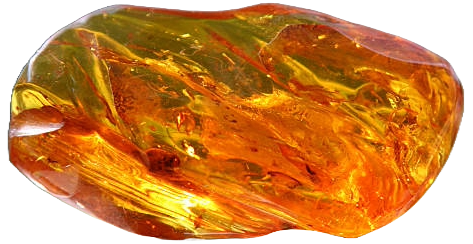
The English word ‘amber’ originates from the Arabic and Middle Persian word ambar, which initially referred to ambergris—a waxy substance derived from sperm whales. Over time, by the 14th century, Middle English adopted the term. Consequently, owing to their shared presence along shorelines, ‘yellow amber’ and ‘grey amber’ (ambergris) became associated. In contrast to ambergris, however, amber is denser than water but lighter than stone.
The classical Latin term electrum and its Greek counterpart elektron both trace back to elektor, meaning ‘beaming Sun.’ Not only do these words reference amber’s warm, golden glow, but they also gave rise to the term ‘electricity’ because of amber’s ability to generate a static charge
Composition, Physical Characteristics, and Varieties
Amber is an organic gemstone formed from the fossilised resin of ancient trees. It consists primarily of carbon, hydrogen, and oxygen, with trace elements and inclusions that add to its diversity.
Amber occurs in a range of hues, from golden yellow and deep orange to green, blue, and even rare red shades. It often contains trapped insects, plant material, and air bubbles, offering valuable insights into prehistoric ecosystems.
Geographical Locations
Amber is predominantly found in:
- The Baltic region (Lithuania, Poland, Russia, Estonia, Latvia)
- Dominican Republic (notable for its rare blue amber)
- Myanmar (Burma) (yielding high-quality amber since ancient times)
- Mexico, Colombia, and Indonesia
Baltic amber, the most famous variety, dates back approximately 40 million years and is highly prized in jewellery and artefacts.
Archaeological and Significant Finds
Amber artefacts date back to the Stone Age, found in gravesites as amulets, beads, and carved pendants. The Mycenaeans and other Mediterranean civilisations also used amber for ornamental purposes.
During the Roman Empire, amber was traded along the ‘Amber Road’ from the Baltic to Rome. It was believed to hold protective properties, making it highly desirable among the nobility.
Interesting Facts
- Amber can contain perfectly preserved insects, some over 100 million years old.
- When rubbed, amber produces static electricity, attracting small particles.
- Amber oil, extracted when heated, was historically used in perfumery and medicine.
- The scent of burning amber resembles pinewood due to its resinous origins.
Folklore, Legends, and Tales
Ancient cultures wove many legends around amber.
In Greek mythology, the historian Nicias believed amber was the congealed sweat of the Earth as the Sun set into the ocean. Another tale involves Phaethon, the son of Helios, who lost control of the Sun chariot. Zeus struck him down to save the world, and in their grief, his sisters transformed into poplar trees, weeping amber tears.
In Chinese tradition, amber was thought to house the souls of tigers after death. It was commonly burned during festivities for its fragrance and used in medicine.
A famous Lithuanian tale tells of Jurate, a sea goddess who lived in an amber palace. She fell in love with a mortal fisherman, Kastytis, angering her father, Perkunas, the God of Thunder. In his rage, Perkunas destroyed the amber palace, killing Kastytis and imprisoning Jurate for eternity. The amber pieces that wash up on the Baltic shores are said to be fragments of her shattered home, and the tear-shaped pieces symbolise her eternal sorrow.
Ovid, the Roman writer describes the tale that amber is the crystallised tears of his mother Clymene and her daughters. The family were so grief stricken, after Phaethon’s death, they were transformed into poplar trees.
Mystical Healing Properties
Amber is believed to:
- Absorb negative energy and provide protection.
- Relieve stress, anxiety, and depression.
- Aid physical healing, especially for pain relief.
- Promote vitality and enhance creativity.
Amber has long history in folk medicine for its alleged healing properties. Amber and its extracts have been used for a wide variety of treatments from the time of Hippocrates in ancient Greece through to the Middle Ages and to the early twentieth century.
The Roman historian, Pliny notes in his Natural History that some people believed amber could help with problems with the tonsils, mouth, and throat, as well as mental disorders and the bladder. Amber was ground and mixed with rose oil and honey to treat eye and ear infections. Amber contains succinic acid which is a mild antibiotic which was used before modern antibiotics.
The Vikings believed animal carved in amber inherited the strengths of the original animals. In Ancient Greek and Roman times, women wore amber fish, frog, and rabbit figurines to ensure fertility.
Traditional Chinese medicine still uses amber to “tranquilise the mind”.
Astrology and the Zodiac
Amber is linked to Leo, representing the Sun’s warmth and life-giving energy. It is also associated with Cancer, offering emotional stability, and Aquarius, fostering intellectual clarity.
The Chakra System
Amber resonates primarily with the Solar Plexus Chakra, promoting self-confidence and personal power. It also influences the Sacral Chakra, encouraging creativity and emotional balance.
Birthstone and Wedding Anniversary Use
Amber is an alternative birthstone for November and is linked to the 10th wedding anniversary. It symbolises longevity, warmth, and protection, making it a cherished gift for significant milestones.
